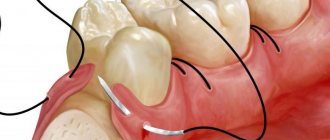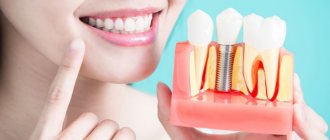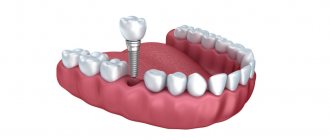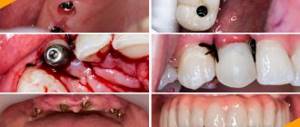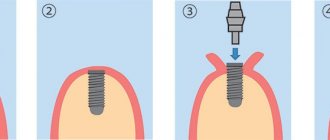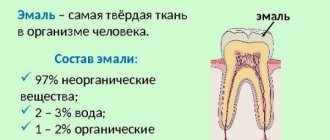Today, implantation is the most advanced way to restore lost teeth. An implant is an artificial root implanted into the jaw bone, which creates the basis for an artificial tooth. This type of prosthetics is the most comfortable and aesthetically pleasing for everyday life.
Although dental implants have been widely used in dentistry for many years, before deciding to undergo such a procedure, most people want to know whether it is painful. Such a desire is quite natural, because fear of pain is one of the most powerful human phobias.
The whole truth about pain during implant installation
Dental implantation is the most modern way to restore teeth. It has replaced outdated removable dentures, as it allows you to quickly and painlessly install a high-quality implant. To find out whether pain is felt during implantation or not, you need to understand how this process occurs. The dental implantation procedure must be performed under anesthesia. Before starting treatment, the dentist injects an anesthetic and only after it takes effect does the implantation process begin. This procedure takes about half an hour. In most cases, the dentist uses local anesthesia for pain relief. And only in severe cases general anesthesia is used. It follows that implantation is absolutely painless and safe for the patient.
50% discount on AstraTech implant installation, Sweden
How painful do patients experience swelling after the procedure?
When it comes to restoring a number of teeth, there is a high probability of postoperative swelling and pain. Both can be relieved by taking medications prescribed by a doctor and require adherence to a certain regimen. Firstly, it is better to stay in the dental clinic for some time after the operation. In specialized dentistry, a rest room is provided for these purposes. Secondly, you shouldn’t get behind the wheel right away - it’s better to call a taxi or drive home with someone close to you. Thirdly, for the first two weeks you should not play sports, carry heavy weights, visit a bathhouse or solarium, or drink alcohol or smoke.
General or local anesthesia for dental implantation?
Before performing the implant installation procedure, the dentist performs a thorough examination of the patient’s oral cavity, studies X-rays and the patient’s medical history. Based on the current situation, he decides whether to use local or general anesthesia for implantation.
If the patient is to have no more than six implants installed at once, then to eliminate pain it is sufficient to use local anesthesia, which the dentist will choose, for example, conduction or infiltration. During the action of this anesthesia, the patient does not feel anything, only the touch of the dentist’s hands on the oral cavity.
It happens that the patient experiences a strong feeling of fear and anxiety, which he is unable to cope with even after using an anesthetic. In this case, in addition to local anesthesia, the dentist may use sedation, during which the patient’s central nervous system is inhibited, resulting in half-sleep. With the help of such combinations, dental implantation can be carried out easily and comfortably.
The use of general anesthesia during dental implantation is advisable in the following cases:
- If the patient needs to have more than six implants installed at once.
- Carrying out simultaneous implantation of bone tissue correction (transplantation of patient bone blocks, sinus lift).
- Allergic reaction to all types of local anesthetic.
- When the patient has a strong and uncontrollable fear of the upcoming treatment.
- A gag reflex that the patient is unable to restrain.
The use of general anesthesia before implantation will allow the dentist to calmly install the implant, which will guarantee a high-quality result and will not cause harm to the patient’s health.
Feelings after implantation
During installation of the implant, the patient only feels some manipulations in his mouth. There is no pain or other negative sensations. But what happens when the anesthesia wears off? It is worth considering here that each body reacts differently. Implantation does not fall into the category of serious interventions. Many patients go to work the next day without any problems. Others have to take painkillers. The condition after surgery and the speed of recovery depend on several factors:
- Features of the body, rate of tissue restoration.
- Volume of intervention – it is much easier to recover after one or two implants than after a larger implantation.
- Location of implants – pain may be more intense in the upper jaw.
Post-implantation pain and swelling
Toothache is an unpleasant sensation that the patient may feel after the anesthetic wears off. The pain can be spread throughout the entire oral cavity or in one place, and can be shooting or radiating in nature. Symptoms of pain can be: pressing, squeezing pain, cutting, dull, throbbing, pain in the form of an attack, tugging, sharp pain. Sometimes itching of the gums occurs at the site of dental implants.
The feeling of pain after installation of a dental implant is in most cases associated with the appearance of edema - the body’s reaction to the resulting wound. This pain occurs when tissues and muscles are compressed. The amount of swelling after dental implantation directly depends on the complexity of the operation and the need for bone grafting. There are no pain receptors in the bone tissue itself, so the feeling of pain arises from cutting the periosteum and muscles. But it is done only for certain types of dental implantation. Therefore, before the upcoming treatment, it is worth discussing with your dentist the possibility of using a non-surgical implantation method. After it, the patient does not experience pain and swelling does not occur.
Whatever method the dentist chooses to insert the implant, after tooth implantation, decongestants and painkillers are prescribed. Most often these are tablets, sometimes infusion therapy through droppers.
To ensure rapid healing of the wound and disappearance of swelling, the patient should follow the recommendations indicated by the dentist:
- in the first days after the implants are inserted, physical activity should be avoided;
- do not touch the sore spot with your tongue or foreign objects;
- do not visit the sauna or take a hot bath;
- Avoid drinking alcohol and limit smoking.
How to make the rehabilitation period easier
First of all, it is important to strictly follow the doctor’s recommendations. Do not put stress on the area where the operation was performed or consume irritating foods or drinks. You should also give up alcohol and smoking, and not play sports. Swelling is a common consequence of root grafting surgery. This is a normal reaction of the body. The main thing is to ensure that all negative feelings gradually subside. If the swelling does not go away or gets worse, pain or redness appears, this is a reason to visit a doctor as soon as possible.
Is dental implantation dangerous for the patient?
The implant installation process itself is easy. But sometimes various complications can arise. This may be rejection and subsequent loss of the installed implant. This complication is not a condition that threatens the life and health of the patient. A consultation with a dentist is sufficient, who will prescribe a further treatment plan.
The risk of damage or rupture of the main vessels or nerve trunks is practically impossible, since the main processes take place on the hard tissues of the patient’s jaw. Even if the mandibular nerve is damaged while the dentist is placing the implant, modern microvascular surgery can easily regenerate the damaged nerve.
How to install implants
Anesthesia is performed only during surgical interventions. Prosthetics is a painless procedure. The implantation process consists of several stages:
First surgical – implant installation
The procedure begins with anesthesia. The patient is injected with an anesthetic into the area where the artificial root is installed. If the operation is performed under sedation, the anesthesiologist will first administer a sedative intravenously. The gum is peeled off, and a bed for an artificial root is created in the bone using special instruments. The implant is inserted into the prepared hole, a plug is fixed on top, and the tissue is sutured. The operation lasts 15-30 minutes. The anesthesiologist brings the patient out of a half-asleep state, after 20-30 minutes the patient can move independently, even drive a car. The next appointment is scheduled in 10 days to remove the stitches. The implant takes 2-4 months to take root in the lower jaw and up to six months in the upper jaw.
The second surgical stage is the installation of a gum former
After engraftment with the jaw bone, the implant is opened, the plug is removed, and a former is inserted. The procedure is performed under local anesthesia and lasts no more than 10 minutes. The former is installed for 10-14 days to create an even gingival contour.
Prosthetics
This stage is completely painless, because... no tissue incisions are required. The former is replaced by an abutment that connects the implant and the prosthesis. A crown is installed on it, made from previously taken impressions.
Opinions of patients and dentists about implantation
Many people are interested in the question of whether it hurts to get dental implants. Patients to whom the dentist has placed implants say that the implantation is painless, although there is discomfort from the touch of instruments or the doctor’s hands. Unpleasant sensations may occur after the procedure itself, but they can easily be eliminated with the help of medications prescribed by the dentist. Many patients claim that removing a diseased tooth is much more unpleasant than the process of implanting an implant.
Installing dental implants is not difficult for a qualified dentist. This procedure takes about an hour and usually does not cause complications. According to dentists, dental implantation is the best option for restoring the beauty of the dentition. Modern dental implants replace not only the top, but also the root of the tooth. They become a complete analogue of a real tooth. This allows the patient’s jaw system to function in its usual way, evenly distributing the load on the teeth.
Many patients mistakenly consider implantation to be too complicated and even dangerous. Pain during dental implantation is completely eliminated, and modern methods of installing implants can minimize the occurrence of complications. High-quality anesthesia before implantation is the key to comfortable treatment, which allows the dentist to quickly and calmly carry out this procedure, and the patient not to worry about whether acute pain will appear during the operation. The outcome of the entire implantation depends on this.
Don’t be afraid of going to the dentist, because modern treatment methods are absolutely painless and safe for health. The dentist will help you choose the appropriate option for restoring a lost tooth, making your smile full and beautiful.
Types and benefits of dental implants
In modern dental clinics, high-quality implants from world manufacturers are used to restore the aesthetics and functionality of the dentition. All designs are divided into several groups.
Types of dental implants: description
, indications for installation:
1. Root-shaped - the most popular dental implants are cylindrical in shape with threads. The main design is a titanium pin. The implant takes root quickly, the risks of postoperative complications are the lowest. Installed when there is sufficient bone tissue.
2. Plate implants have a porous plate with a pin. Can be used if the bone tissue is too thin, when installation of a root-like structure is considered impossible. They are not designed for heavy loads, so they are mainly used to restore front teeth.
3. If there is a lack of bone tissue, subperiosteal implants, implanted into the space between the bone and the gum, are also effectively used. Recommended for installation after long-term absence of teeth.
4. Mini-implants are the optimal design for installation in patients who are contraindicated for full dental implantation. Such implants are used in single quantities and are not suitable for restoring a whole series.
On the dental implant market, global manufacturers present a wide variety of designs for restoring lost teeth, each with its own characteristics, advantages and disadvantages. Before carrying out a surgical procedure to implant an artificial tooth, it is very important to choose a high-quality implant with good performance characteristics and rapid healing.
What are the features of prosthetics for anterior teeth?
Any specialist understands perfectly well how important his smile is for a person, because it is a kind of business card, which means it is the first thing we pay attention to when meeting or getting to know each other. A lot depends on its beauty: the success of the transaction, personal relationships and - most importantly - the psychological state of its owner. Therefore, every time doctors are faced with the need to restore a front tooth, they are faced with an important and difficult task: to quickly and efficiently carry out the procedure. Prosthetics of the front tooth requires not only the correct recreation of the function, shape and color of the tooth, but also requires paying special attention to the “pink aesthetics”, that is, the gum.
Recommendations after surgery
Most often, implant rejection occurs due to the patient’s fault (failure to follow the dentist’s recommendations, failure to go to the clinic in a timely manner in case of complications, self-medication).
In order for the implant to take root, you need to follow a number of simple recommendations:
- Do not eat for 2 hours;
- During the entire healing period, do not eat spicy or too hard foods, avoid cold or hot foods;
- You can only chew on the side of the jaw opposite the sutures (to avoid their divergence);
- Take anti-inflammatory and painkillers recommended by your doctor, do antiseptic baths and rinses.
- Daily regular oral hygiene (brushing and paste, rinsing, flossing, etc.);
- If swelling occurs, apply ice to the cheek;
- Avoid any types of serious physical activity, avoid overwork;
- Smoking and drinking alcohol are ideally allowed only 1-2 weeks after surgery;
- Avoid active articulation, sneeze and cough very carefully;
- Add as many vitamins, minerals and nutrients to your diet as possible.
If these simple recommendations are followed, implant rejection, as well as the occurrence of any other serious complications, are excluded.
To avoid problems during implantation surgery, as well as in the postoperative period, you should give preference to trusted clinics and experienced, highly qualified specialists.
Free consultation on the cost of treatment in our dentistry
Leave a request and the clinic administrator will contact you within 15 minutes!
NOTE: Gold crowns are considered an outdated option, although even today some patients order dentures made from this precious metal. In this case, the cost of the crown will depend on the amount and weight of the metal, as well as its current price per gram.
Which crown to put on a tooth? The answer to this question depends on a number of factors - for example, when restoring chewing teeth, there is no point in spending money on expensive ceramic crowns, but in order to achieve high quality and maximum durability of prosthetics, you can install zirconium teeth.
Dental bridges
Bridges are used when it is necessary to install 2 teeth or restore more units in a row. Their basis is a frame on which artificial dental units are placed. The main condition for placing a bridge on teeth is the presence of teeth that will support the structure.
The price of bridges largely depends on the material used to make them. The most expensive option is ceramic and zirconium structures.
A separate type of fixed prosthesis are veneers and lumineers, used in aesthetic dentistry. It is impossible to replace a tooth lost due to injury or disease using veneers and lumineers, since they are attached to the surface of the teeth and are intended solely to eliminate aesthetic defects of the teeth.
How much does it cost to put veneers on teeth? The price of installing veneers will depend on the type of prosthesis: veneers can be composite, ceramic, zirconium.
Why can’t you “walk without a tooth”?
The absence of even one tooth entails a number of unpleasant consequences for the health of the oral cavity and the body as a whole. The insidious thing is that these consequences occur very systematically and unnoticed by the patient.
- The chewing load on neighboring teeth increases and, as a result, their lifespan is reduced
- Neighboring teeth, without the support that was present before, begin to move and try to close the resulting gap. As a result, the teeth become crooked and the correct bite is disrupted.
- Aesthetic discomfort (especially important for front teeth)
- Gastrointestinal problems due to poorer chewing of food.
Patient reviews
I have no fear of dentists, so the local anesthesia took place without the use of sedatives. The dentist gave the Ultracaine injection correctly, so after 10 seconds I informed him about the onset of numbness. I didn’t feel any pain, but during the procedure I felt the cold of the suction tube and any movements of the instruments. There was discomfort when the hole for the dental implant was made. But I didn’t feel anything when the tissues were deformed.
Valery, 27 years old, Ekaterinburg
After studying the x-ray, the dentist said that bone grafting was indispensable. I agreed to undergo additional surgery. They injected an anesthetic, so I didn’t feel any pain during the procedure. The dentist prescribed painkillers in tablets and told me to take them for at least 5 days. I didn’t take the pills lightly so that their effects wouldn’t affect the liver. As a result, as soon as the numbness completely passed, severe pain began. I didn’t last 10 minutes - I drank the drug. I warn others, follow the recommendations of doctors.
Elena, 32 years old, Ufa
In addition to my fear of dentists, I am allergic to Articaine.
Therefore, the procedure was performed under general anesthesia. The implantation went well, I did not feel anything before and after the operation. Some difficulties arose during prosthetics. When I was wearing a temporary crown, part of the gums in the operated area became swollen and pain and tingling began. The discomfort disappeared after 3 days of taking antibiotics. Svetlana, 48 years old, Kazan
What teeth can be put in place of extracted or lost teeth?
As we said above, even if only one unit is missing in the dentition, this is already a serious problem! And you urgently need to get an artificial tooth that will be able to perform all the functions of the lost unit and at the same time restore the aesthetics of your smile.
In Moscow, dental clinics use different technologies that allow teeth to be placed:
- 1. Removable and fixed prosthetics.
- 2. Implantation.
The choice of technology with which to place a tooth will depend on the price of the restoration service, as well as its reliability, aesthetics and durability.
Therefore, it is worth learning in advance about all the techniques, the use of which will allow you to replace the tooth in the place of the removed one. Below we will tell you in detail about removable, fixed prosthetics and implantation, which are the main technologies for restoring teeth in modern dentistry.
Removable prosthetics
Removable dentures are an opportunity to place a tooth cheaply, since the prices for removable dentures are quite affordable and accessible to a wide range of patients. Removable prosthetics are resorted to in cases of a completely toothless jaw, in the absence of four dental units in a row. A removable denture can also be placed as a temporary tooth - for example, in preparation for implantation or fixed prosthetics.
In removable prosthetics, special designs are used - dental prostheses, which a person can put on and take off himself if necessary. Hence the name of the technology. Of course, removable prosthetics allows you to install a tooth inexpensively, but it has a lot of disadvantages, including:
1. Low level of aesthetics. If you are interested in the answer to the question of which tooth to replace the extracted tooth in the smile area, let us say right away that a removable denture is not suitable for this purpose.
absolutely! Artificial teeth for removable dentures are made of acrylic plastic and do not look very natural! In addition, acrylic quickly loses its beautiful whiteness under the influence of external factors;
2. Low level of wearing comfort. Having decided to install a removable dental prosthesis, you need to be prepared for the fact that the process of adaptation to it can take a long time, diction problems may occur, and the structure itself can easily fall out during an active conversation or eating;
3. Another significant disadvantage that is definitely worth considering if you decide to install teeth and use a removable denture for this purpose is the fact that removable structures do not ensure proper distribution of the chewing load, and this is fraught with atrophy of the jaw bone.
What will the cost if you decide to replace your teeth with removable dentures? The price of the service depends on the material used to make the prosthesis (acrylic, nylon, silicone) and its type: full or partial.
Fixed prosthetics
Fixed dentures - just from the name of the designs it becomes clear that a person cannot remove them on his own, only with the help of a doctor. Fixed prosthetics should be considered as an opportunity to install teeth both in case of multiple missing teeth in rows and in case of single defects. A fixed denture is one of the answer options to the question of which tooth is best placed in front, in the smile zone, since dentures of this type are made of durable and at the same time aesthetic materials and are visually no different from natural teeth!
Fixed dentures come in different types, and we will discuss each of them in detail below.
Tabs
They belong to non-removable microprostheses and are a more reliable and durable alternative to conventional fillings made of photopolymers.
Using an inlay, you can qualitatively restore a partially destroyed tooth. How much does it cost to install a tooth using an inlay? The answer to this question will largely depend on the material used to make the microprosthesis: inlays are made of ceramic, zirconium and even gold.
Crowns
Crowns are used in cases where it is necessary to replace a tooth that has been removed and lost due to injury, as well as, if necessary, to qualitatively restore a unit that has been destroyed by caries by more than 50%.
Crowns can also be used for the aesthetic correction of teeth with an irregular and unattractive shape. If you decide to put a crown on a tooth, the price of the service will depend primarily on the material used and the production technology of the prosthesis. Crowns are made from materials such as:
1. Dental ceramics. put ceramic crowns on your teeth at a cost of 20,000 rubles per unit. This price may seem high, but it is fully compensated by the aesthetics, durability and reliability of ceramic crowns;
2. Zirconium dioxide. One of the most modern materials that began to be used for the production of dental crowns. Placing zirconium crowns on teeth in Moscow will be expensive - from 30,000 rubles per unit, but zirconium is the best material for restoring lost chewing teeth, because it has maximum strength;
3. Metal ceramics. The frame of such crowns is made of metal - precious or non-precious and on top, to obtain an aesthetic appearance, the crown is covered with a layer of ceramic mass. How much does it cost to install a metal-ceramic tooth ? The price of prosthetics in this case will depend on the material used to make the frame. It is clear that gold crowns will be the most expensive option!
When is it necessary to remove a tooth along with the root?
All decent dentists try to preserve “their” patient’s tooth in every possible way. Even if we are talking only about the remaining root, today there are also several restoration options. One of the most popular is prosthetics using a stump tab.
However, in some cases complete extraction of the tooth is indicated, i.e. removal of both the coronal part and the root.
Indications for root removal:
- granulomas or cysts that do not respond to drug treatment;
- destruction or severe deformation of the root;
- inability to treat root canals (usually also due to deformation or non-standard shape);
- maxillary osteomyelitis;
- periodontitis or periodontal disease in a late advanced stage. In this case, the roots of the teeth have increased mobility and also act as a kind of “foundation” for tartar;
- cracks in the root or perforated bottom (such phenomena are contraindications for prosthetics using a stump inlay);
- “forgotten” fragments of dental instruments that cannot be removed;

